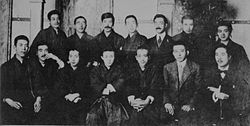Artist group Shirakaba
The Japanese artist group Shirakaba ( Japanese 白樺 派 ), named after their magazine Shirakaba , which they published between 1910 and 1923, was an association of young Japanese intellectuals who dealt with modern literature and art.
The group
Mushanokōji Saneatsu and Shiga Naoya , who knew each other from the training facility of the Japanese aristocracy, the Gakushūin , planned to publish a magazine from 1907 that would not only present modern Japanese literature and art, but also report on developments in Europe in these areas should. At the end of 1907 the group, which had also joined Ōgimachi Kinkazu ( 正 親 町 公 和 ) and Kinoshita Rigen , who had also visited the Gakushuin, decided, at the suggestion of Shiga, to name the planned magazine “Shirakaba” (“The Birch”). This tree was chosen because it was not traditionally Japanese and because of its black and white drawing it was also graphically striking. For the first issue of the magazine, which appeared from 1910, you could win Natsume Sōseki for a contribution. The title page for the first issue was drawn by Kojima Kikuo ( 児 島 喜 久 雄 ).
Other members of the group included a. Satomi Ton , the folklorist Yanagi Muneyoshi , the writer Sonoike Kin'yuki ( 園 池 公 致 ), Miura Naosuke ( 三浦 直 介 ), the brothers Arishima Takeo and Ikuma , Takamura Kōtarō , Nagayo Yoshirō , Koizumi Magane ( 小泉 鉄 ), Kusaka Minoru ( 日下 稔 ). The Tokyo-based graphic artist and later potter Bernard Leach had close contact with the group .

The contact with Worpswede
As far as European fine arts were concerned, the group of artists dealt with modernism in France (including Rodin ), Art Nouveau and symbolism in Germany, Switzerland and Austria ( Klinger , Böcklin , von Stuck ). In Germany, contact was also made with Heinrich Vogeler . How this contact came about can no longer be determined today; it was exhibited for the first time in Japan in 1910. Letters from Yanagi to Vogeler, written in good German, have been received since the end of 1911. This is how he writes Dear Sir! On December 12th I received your portrait and seventy-seven etchings with dear friends. I reported it to my friends with great impatience ...
- In 1911 the Taisei exhibition took place in the Reinanzakashita-Sankaidō, an exhibition on which Vogeler was represented with 14 etchings, along with other Worpswede artists. In 1912 the group brought out a special issue (Volume 2, Issue 12) on Vogeler, in which etchings and ex libris were printed, together 92 illustrations with price information.
- In 1912 Vogeler was given its own room for 38 etchings within the 4th Shirakaba exhibition .
Then contact with Vogeler broke off, after the Kanto earthquake in 1923 the group broke up. In 1979, the Riccar Art Museum Tokyo, which specializes in graphics, organized an exhibition for Vogeler, where Worpswede was also presented with photos and documents from the artist colony (including Rilke).
Remarks
Individual evidence
- ↑ Imai, Nobuo and Mita, Masahito (eds.): Mushanokoji Saneatsu . Shinchosha, 1984. ISBN 4-10-620610-2 . P. 24.
literature
- Riccar Art Museum (Ed.): Heinrich Vogler . Exhibition catalog Tokyo, 1979.
- Kanagawa Bungaku Shinkokai (Ed.): Mushanokoji Saneatsu to Shirakaba bijutsu-ten. Exhibition catalog Tokyo, 1985.
